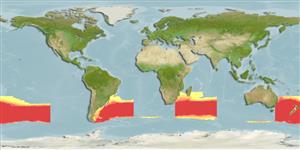>
Aulopiformes (Grinners) >
Paralepididae (Barracudinas)
Etymology: Magnisudis: Latin, magnus = large + Latin, sudis = esox, fish of the Rhine, cited by Plinius 9.15; it also means "stake" (Ref. 45335).
Environment: milieu / climate zone / depth range / distribution range
Ekologi
laut batipelagis; kisaran kedalaman 0 - 1000 m (Ref. 4056), usually 300 - 800 m. Deep-water; 20°S - 60°S
Probably circumglobal in the Southern Ocean from about 20°S to Antarctica. Specimens south of the Antarctic Convergence probably expatriated.
Size / Weight / umur
Maturity: Lm ? range ? - ? cm
Max length : 55.0 cm TL jantan/; (Ref. 4056)
Duri punggung (Keseluruhan (total)): 0; duri punggung lunak (Keseluruhan (total)): 9-11; Duri dubur 0; Sirip dubur lunak: 22 - 25. Body pale with brownish dorsal band (Ref. 4056).
Vertically, juveniles occur from near surface to about 200 m and adults down to 1,000 m but mainly between 300-800 m. Feeds mainly on fishes.
Life cycle and mating behavior
Kematangan | Reproduksi, perkembang biakan | Pemijahan | telur-telur | Fecundity | Larva
Post, A., 1990. Paralepididae. p. 138-141. In O. Gon and P.C. Heemstra (eds.) Fishes of the Southern Ocean. J.L.B. Smith Institute of Ichthyology, Grahamstown, South Africa. (Ref. 5176)
Status IUCN Red List (Ref. 130435)
ancaman kepada manusia
Harmless
penggunaan manusia
informasi lanjut
Umur / SaizPertumbuhanpanjang-beratpanjang-panjangukuran frekuensiMorfometrikMorfologiLarvaDinamika larvapemulihanKelimpahanBRUVS
AcuanBudidaya airprofil budidaya airStrainGenetikaElectrophoresesDiturunkanPenyakit-penyakitPengolahanNutrientsMass conversion
mitraGambarStamps, Coins Misc.Suara-suaraCiguateraKecepatanTipe renangArea insangOtolithsOtakPenglihatan / visi
Alat, peralatan
laporan khas
muat turun XML
Sumber internet
Estimates based on models
Preferred temperature (Ref.
123201): 2.7 - 9.9, mean 6.8 °C (based on 393 cells).
Phylogenetic diversity index (Ref.
82804): PD
50 = 0.6250 [Uniqueness, from 0.5 = low to 2.0 = high].
Bayesian length-weight: a=0.00224 (0.00090 - 0.00555), b=3.14 (2.92 - 3.36), in cm total length, based on LWR estimates for this (Sub)family-body shape (Ref.
93245).
Trophic level (Ref.
69278): 4.5 ±0.80 se; based on food items.
Fishing Vulnerability (Ref.
59153): Moderate vulnerability (42 of 100).
Nutrients (Ref.
124155): Calcium = 22 [7, 65] mg/100g; Iron = 0.296 [0.100, 0.908] mg/100g; Protein = 16 [13, 18] %; Omega3 = 0.101 [0.026, 0.320] g/100g; Selenium = 16.7 [5.4, 47.8] μg/100g; VitaminA = 31.4 [3.3, 258.7] μg/100g; Zinc = 0.376 [0.200, 0.744] mg/100g (wet weight);
